A Report on Suicide Among LGBTQI Individuals: Causes and Solutions
VerifiedAdded on 2022/11/14
|17
|4372
|390
Report
AI Summary
This report addresses the critical issue of suicide within the LGBTQI community, examining its prevalence, causes, and contributing factors. It highlights the increased risk of suicide among LGBTQI individuals compared to the general population, emphasizing the role of social determinants such as socioeconomic status, education, family rejection, and discrimination. The report provides insights into specific policies and programs designed to address suicide prevention, including the National Mental Health Strategy, Roadmap for National Mental Health Reform, and initiatives like the Family Acceptance Project and the Trevor Project. Furthermore, it discusses the involvement of stakeholders and the importance of a multi-faceted approach to address the mental health needs of the LGBTQI community and prevent suicides. The report aims to raise awareness and advocate for improved support systems and resources to mitigate the risk of suicide among LGBTQI individuals.

Running Head: LGBTQI
0
Suicide among LGBTQI
student
5/22/2019
0
Suicide among LGBTQI
student
5/22/2019
Paraphrase This Document
Need a fresh take? Get an instant paraphrase of this document with our AI Paraphraser
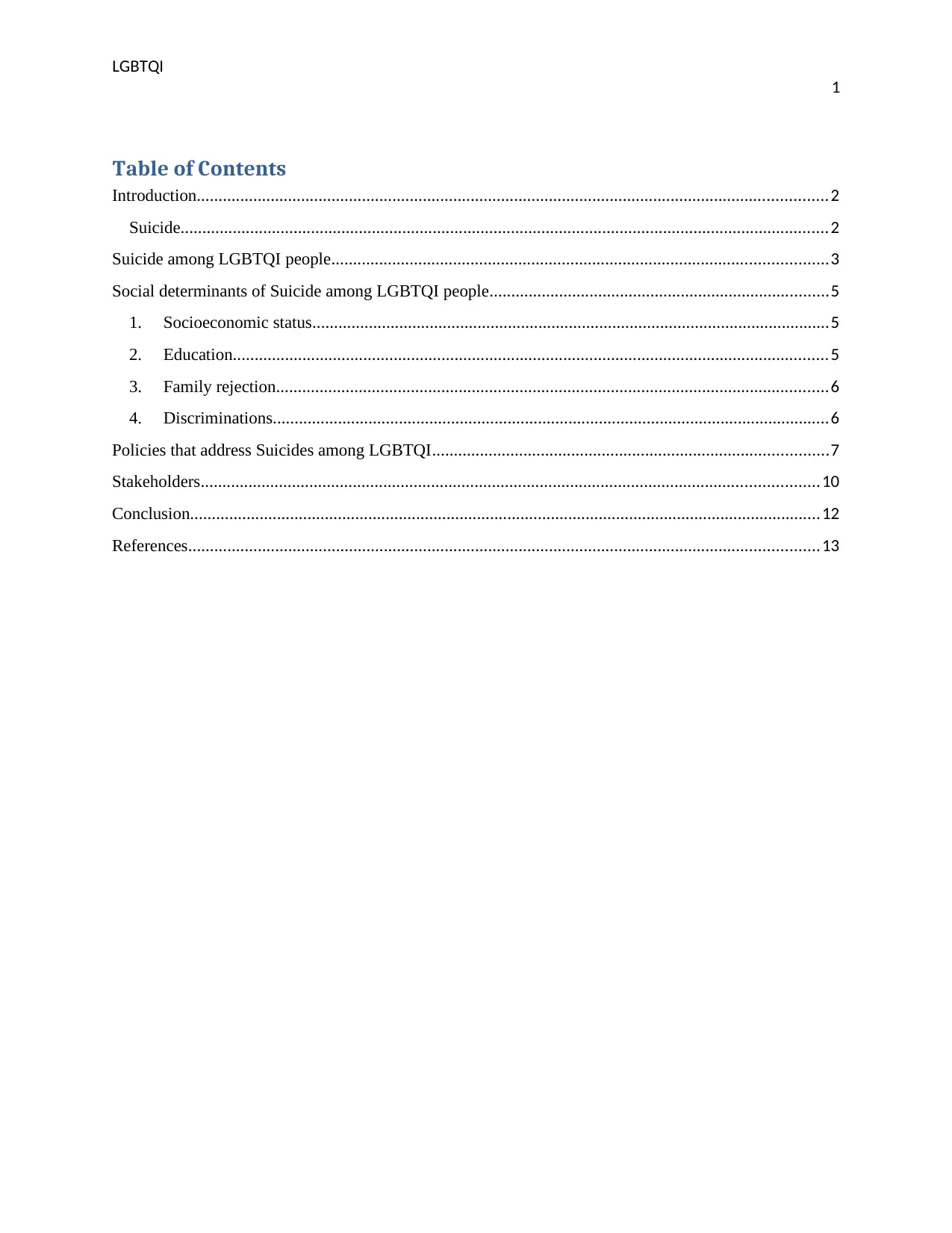
LGBTQI
1
Table of Contents
Introduction.................................................................................................................................................2
Suicide.....................................................................................................................................................2
Suicide among LGBTQI people..................................................................................................................3
Social determinants of Suicide among LGBTQI people..............................................................................5
1. Socioeconomic status.......................................................................................................................5
2. Education.........................................................................................................................................5
3. Family rejection...............................................................................................................................6
4. Discriminations................................................................................................................................6
Policies that address Suicides among LGBTQI...........................................................................................7
Stakeholders..............................................................................................................................................10
Conclusion.................................................................................................................................................12
References.................................................................................................................................................13
1
Table of Contents
Introduction.................................................................................................................................................2
Suicide.....................................................................................................................................................2
Suicide among LGBTQI people..................................................................................................................3
Social determinants of Suicide among LGBTQI people..............................................................................5
1. Socioeconomic status.......................................................................................................................5
2. Education.........................................................................................................................................5
3. Family rejection...............................................................................................................................6
4. Discriminations................................................................................................................................6
Policies that address Suicides among LGBTQI...........................................................................................7
Stakeholders..............................................................................................................................................10
Conclusion.................................................................................................................................................12
References.................................................................................................................................................13
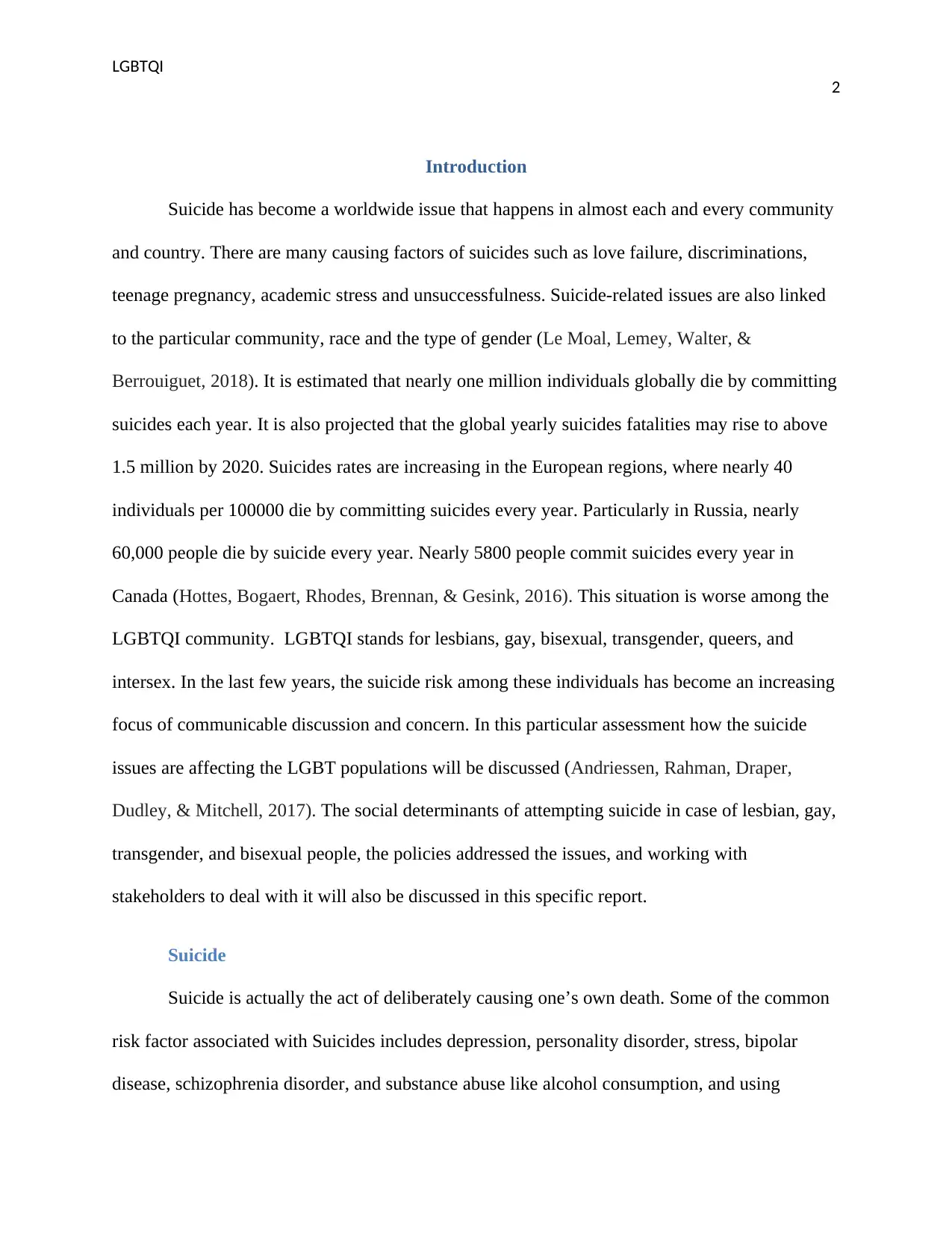
LGBTQI
2
Introduction
Suicide has become a worldwide issue that happens in almost each and every community
and country. There are many causing factors of suicides such as love failure, discriminations,
teenage pregnancy, academic stress and unsuccessfulness. Suicide-related issues are also linked
to the particular community, race and the type of gender (Le Moal, Lemey, Walter, &
Berrouiguet, 2018). It is estimated that nearly one million individuals globally die by committing
suicides each year. It is also projected that the global yearly suicides fatalities may rise to above
1.5 million by 2020. Suicides rates are increasing in the European regions, where nearly 40
individuals per 100000 die by committing suicides every year. Particularly in Russia, nearly
60,000 people die by suicide every year. Nearly 5800 people commit suicides every year in
Canada (Hottes, Bogaert, Rhodes, Brennan, & Gesink, 2016). This situation is worse among the
LGBTQI community. LGBTQI stands for lesbians, gay, bisexual, transgender, queers, and
intersex. In the last few years, the suicide risk among these individuals has become an increasing
focus of communicable discussion and concern. In this particular assessment how the suicide
issues are affecting the LGBT populations will be discussed (Andriessen, Rahman, Draper,
Dudley, & Mitchell, 2017). The social determinants of attempting suicide in case of lesbian, gay,
transgender, and bisexual people, the policies addressed the issues, and working with
stakeholders to deal with it will also be discussed in this specific report.
Suicide
Suicide is actually the act of deliberately causing one’s own death. Some of the common
risk factor associated with Suicides includes depression, personality disorder, stress, bipolar
disease, schizophrenia disorder, and substance abuse like alcohol consumption, and using
2
Introduction
Suicide has become a worldwide issue that happens in almost each and every community
and country. There are many causing factors of suicides such as love failure, discriminations,
teenage pregnancy, academic stress and unsuccessfulness. Suicide-related issues are also linked
to the particular community, race and the type of gender (Le Moal, Lemey, Walter, &
Berrouiguet, 2018). It is estimated that nearly one million individuals globally die by committing
suicides each year. It is also projected that the global yearly suicides fatalities may rise to above
1.5 million by 2020. Suicides rates are increasing in the European regions, where nearly 40
individuals per 100000 die by committing suicides every year. Particularly in Russia, nearly
60,000 people die by suicide every year. Nearly 5800 people commit suicides every year in
Canada (Hottes, Bogaert, Rhodes, Brennan, & Gesink, 2016). This situation is worse among the
LGBTQI community. LGBTQI stands for lesbians, gay, bisexual, transgender, queers, and
intersex. In the last few years, the suicide risk among these individuals has become an increasing
focus of communicable discussion and concern. In this particular assessment how the suicide
issues are affecting the LGBT populations will be discussed (Andriessen, Rahman, Draper,
Dudley, & Mitchell, 2017). The social determinants of attempting suicide in case of lesbian, gay,
transgender, and bisexual people, the policies addressed the issues, and working with
stakeholders to deal with it will also be discussed in this specific report.
Suicide
Suicide is actually the act of deliberately causing one’s own death. Some of the common
risk factor associated with Suicides includes depression, personality disorder, stress, bipolar
disease, schizophrenia disorder, and substance abuse like alcohol consumption, and using
⊘ This is a preview!⊘
Do you want full access?
Subscribe today to unlock all pages.

Trusted by 1+ million students worldwide
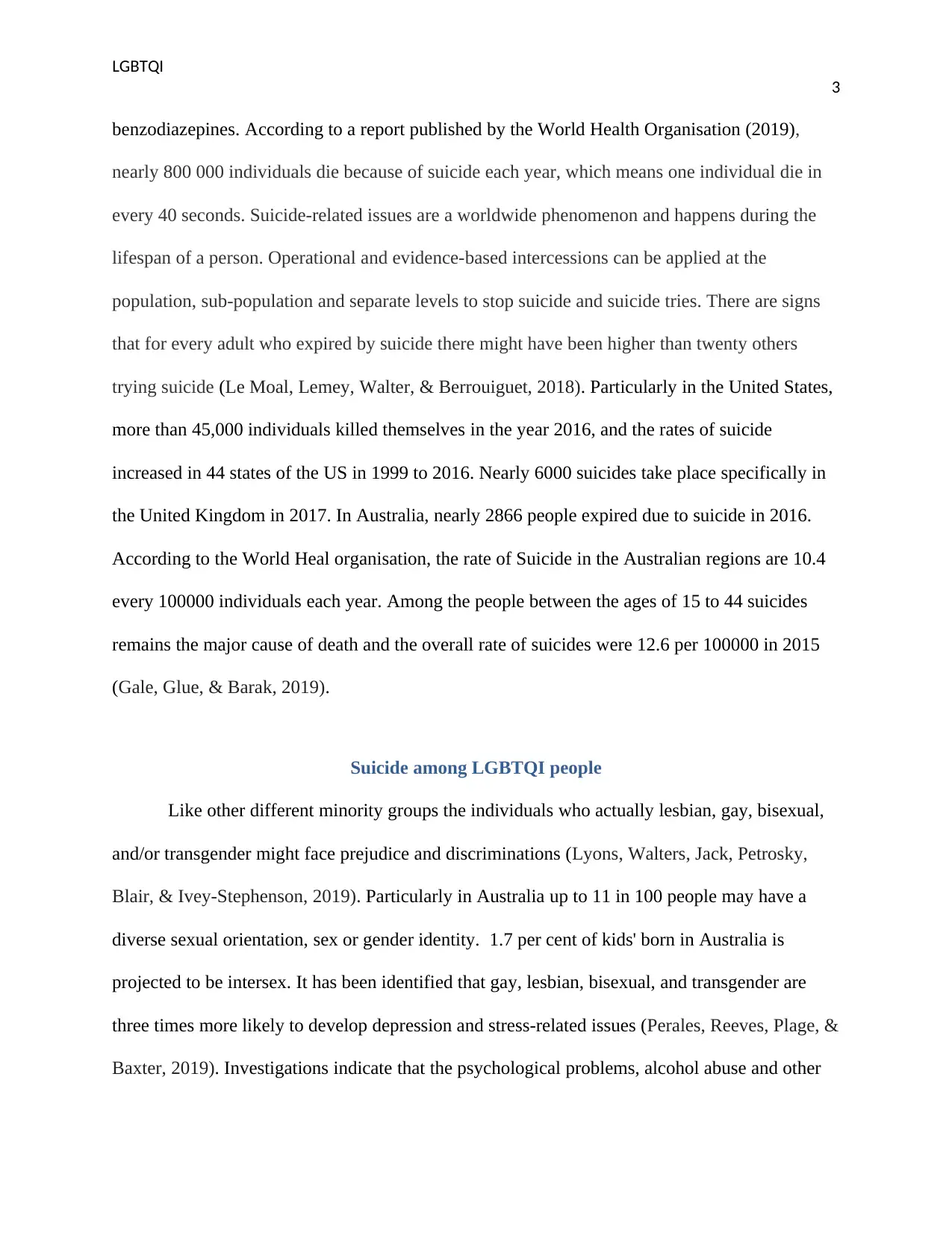
LGBTQI
3
benzodiazepines. According to a report published by the World Health Organisation (2019),
nearly 800 000 individuals die because of suicide each year, which means one individual die in
every 40 seconds. Suicide-related issues are a worldwide phenomenon and happens during the
lifespan of a person. Operational and evidence-based intercessions can be applied at the
population, sub-population and separate levels to stop suicide and suicide tries. There are signs
that for every adult who expired by suicide there might have been higher than twenty others
trying suicide (Le Moal, Lemey, Walter, & Berrouiguet, 2018). Particularly in the United States,
more than 45,000 individuals killed themselves in the year 2016, and the rates of suicide
increased in 44 states of the US in 1999 to 2016. Nearly 6000 suicides take place specifically in
the United Kingdom in 2017. In Australia, nearly 2866 people expired due to suicide in 2016.
According to the World Heal organisation, the rate of Suicide in the Australian regions are 10.4
every 100000 individuals each year. Among the people between the ages of 15 to 44 suicides
remains the major cause of death and the overall rate of suicides were 12.6 per 100000 in 2015
(Gale, Glue, & Barak, 2019).
Suicide among LGBTQI people
Like other different minority groups the individuals who actually lesbian, gay, bisexual,
and/or transgender might face prejudice and discriminations (Lyons, Walters, Jack, Petrosky,
Blair, & Ivey-Stephenson, 2019). Particularly in Australia up to 11 in 100 people may have a
diverse sexual orientation, sex or gender identity. 1.7 per cent of kids' born in Australia is
projected to be intersex. It has been identified that gay, lesbian, bisexual, and transgender are
three times more likely to develop depression and stress-related issues (Perales, Reeves, Plage, &
Baxter, 2019). Investigations indicate that the psychological problems, alcohol abuse and other
3
benzodiazepines. According to a report published by the World Health Organisation (2019),
nearly 800 000 individuals die because of suicide each year, which means one individual die in
every 40 seconds. Suicide-related issues are a worldwide phenomenon and happens during the
lifespan of a person. Operational and evidence-based intercessions can be applied at the
population, sub-population and separate levels to stop suicide and suicide tries. There are signs
that for every adult who expired by suicide there might have been higher than twenty others
trying suicide (Le Moal, Lemey, Walter, & Berrouiguet, 2018). Particularly in the United States,
more than 45,000 individuals killed themselves in the year 2016, and the rates of suicide
increased in 44 states of the US in 1999 to 2016. Nearly 6000 suicides take place specifically in
the United Kingdom in 2017. In Australia, nearly 2866 people expired due to suicide in 2016.
According to the World Heal organisation, the rate of Suicide in the Australian regions are 10.4
every 100000 individuals each year. Among the people between the ages of 15 to 44 suicides
remains the major cause of death and the overall rate of suicides were 12.6 per 100000 in 2015
(Gale, Glue, & Barak, 2019).
Suicide among LGBTQI people
Like other different minority groups the individuals who actually lesbian, gay, bisexual,
and/or transgender might face prejudice and discriminations (Lyons, Walters, Jack, Petrosky,
Blair, & Ivey-Stephenson, 2019). Particularly in Australia up to 11 in 100 people may have a
diverse sexual orientation, sex or gender identity. 1.7 per cent of kids' born in Australia is
projected to be intersex. It has been identified that gay, lesbian, bisexual, and transgender are
three times more likely to develop depression and stress-related issues (Perales, Reeves, Plage, &
Baxter, 2019). Investigations indicate that the psychological problems, alcohol abuse and other
Paraphrase This Document
Need a fresh take? Get an instant paraphrase of this document with our AI Paraphraser
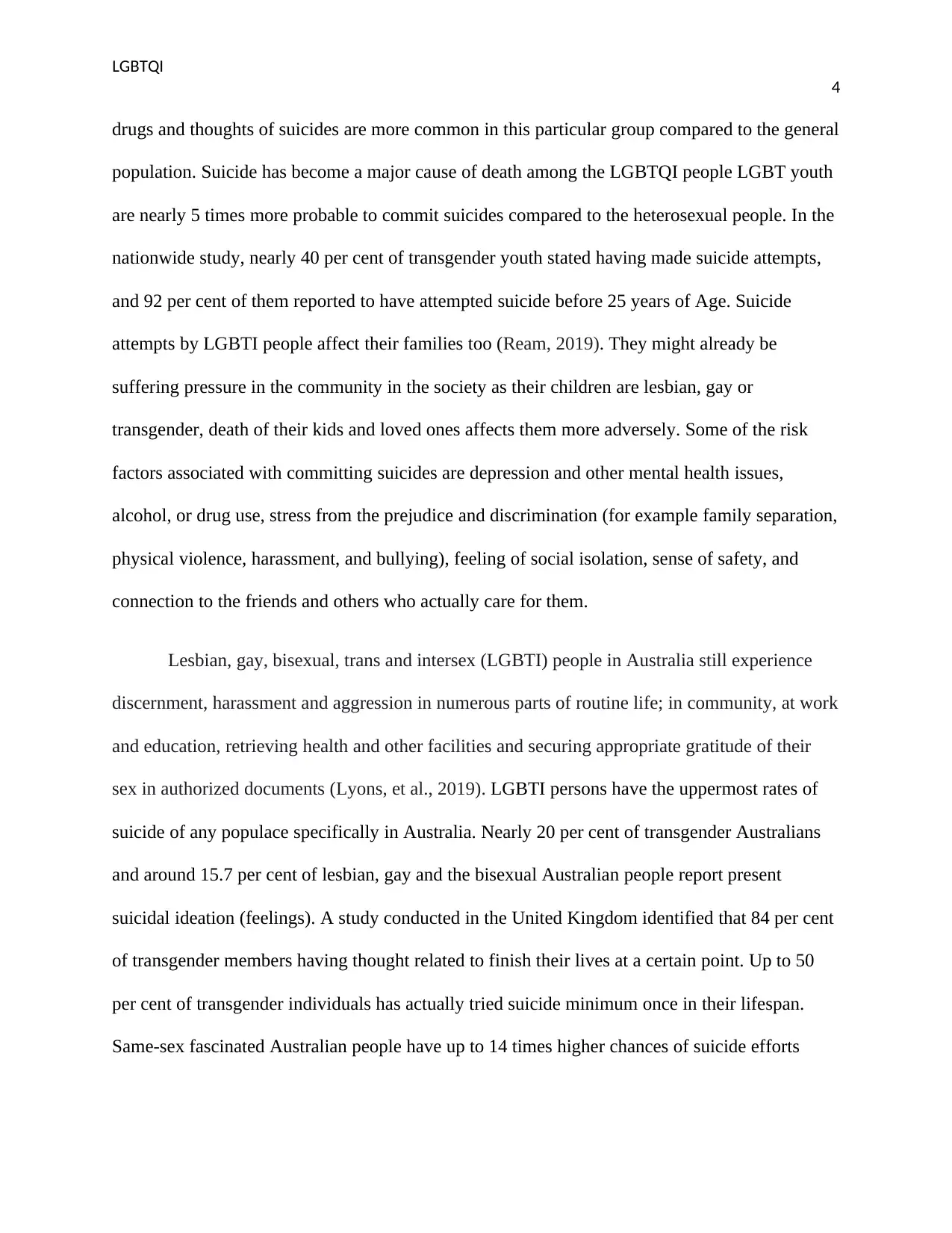
LGBTQI
4
drugs and thoughts of suicides are more common in this particular group compared to the general
population. Suicide has become a major cause of death among the LGBTQI people LGBT youth
are nearly 5 times more probable to commit suicides compared to the heterosexual people. In the
nationwide study, nearly 40 per cent of transgender youth stated having made suicide attempts,
and 92 per cent of them reported to have attempted suicide before 25 years of Age. Suicide
attempts by LGBTI people affect their families too (Ream, 2019). They might already be
suffering pressure in the community in the society as their children are lesbian, gay or
transgender, death of their kids and loved ones affects them more adversely. Some of the risk
factors associated with committing suicides are depression and other mental health issues,
alcohol, or drug use, stress from the prejudice and discrimination (for example family separation,
physical violence, harassment, and bullying), feeling of social isolation, sense of safety, and
connection to the friends and others who actually care for them.
Lesbian, gay, bisexual, trans and intersex (LGBTI) people in Australia still experience
discernment, harassment and aggression in numerous parts of routine life; in community, at work
and education, retrieving health and other facilities and securing appropriate gratitude of their
sex in authorized documents (Lyons, et al., 2019). LGBTI persons have the uppermost rates of
suicide of any populace specifically in Australia. Nearly 20 per cent of transgender Australians
and around 15.7 per cent of lesbian, gay and the bisexual Australian people report present
suicidal ideation (feelings). A study conducted in the United Kingdom identified that 84 per cent
of transgender members having thought related to finish their lives at a certain point. Up to 50
per cent of transgender individuals has actually tried suicide minimum once in their lifespan.
Same-sex fascinated Australian people have up to 14 times higher chances of suicide efforts
4
drugs and thoughts of suicides are more common in this particular group compared to the general
population. Suicide has become a major cause of death among the LGBTQI people LGBT youth
are nearly 5 times more probable to commit suicides compared to the heterosexual people. In the
nationwide study, nearly 40 per cent of transgender youth stated having made suicide attempts,
and 92 per cent of them reported to have attempted suicide before 25 years of Age. Suicide
attempts by LGBTI people affect their families too (Ream, 2019). They might already be
suffering pressure in the community in the society as their children are lesbian, gay or
transgender, death of their kids and loved ones affects them more adversely. Some of the risk
factors associated with committing suicides are depression and other mental health issues,
alcohol, or drug use, stress from the prejudice and discrimination (for example family separation,
physical violence, harassment, and bullying), feeling of social isolation, sense of safety, and
connection to the friends and others who actually care for them.
Lesbian, gay, bisexual, trans and intersex (LGBTI) people in Australia still experience
discernment, harassment and aggression in numerous parts of routine life; in community, at work
and education, retrieving health and other facilities and securing appropriate gratitude of their
sex in authorized documents (Lyons, et al., 2019). LGBTI persons have the uppermost rates of
suicide of any populace specifically in Australia. Nearly 20 per cent of transgender Australians
and around 15.7 per cent of lesbian, gay and the bisexual Australian people report present
suicidal ideation (feelings). A study conducted in the United Kingdom identified that 84 per cent
of transgender members having thought related to finish their lives at a certain point. Up to 50
per cent of transgender individuals has actually tried suicide minimum once in their lifespan.
Same-sex fascinated Australian people have up to 14 times higher chances of suicide efforts
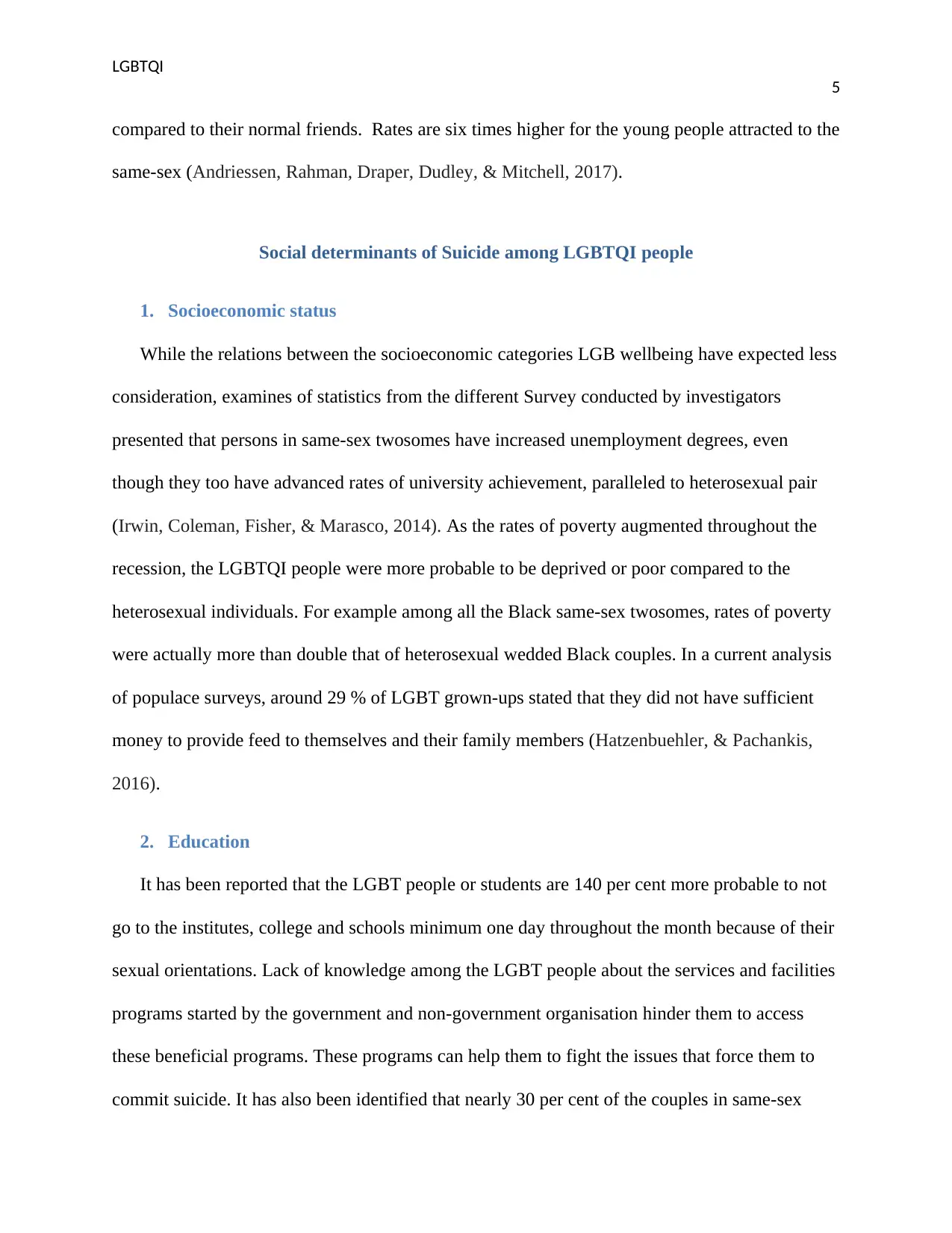
LGBTQI
5
compared to their normal friends. Rates are six times higher for the young people attracted to the
same-sex (Andriessen, Rahman, Draper, Dudley, & Mitchell, 2017).
Social determinants of Suicide among LGBTQI people
1. Socioeconomic status
While the relations between the socioeconomic categories LGB wellbeing have expected less
consideration, examines of statistics from the different Survey conducted by investigators
presented that persons in same-sex twosomes have increased unemployment degrees, even
though they too have advanced rates of university achievement, paralleled to heterosexual pair
(Irwin, Coleman, Fisher, & Marasco, 2014). As the rates of poverty augmented throughout the
recession, the LGBTQI people were more probable to be deprived or poor compared to the
heterosexual individuals. For example among all the Black same-sex twosomes, rates of poverty
were actually more than double that of heterosexual wedded Black couples. In a current analysis
of populace surveys, around 29 % of LGBT grown-ups stated that they did not have sufficient
money to provide feed to themselves and their family members (Hatzenbuehler, & Pachankis,
2016).
2. Education
It has been reported that the LGBT people or students are 140 per cent more probable to not
go to the institutes, college and schools minimum one day throughout the month because of their
sexual orientations. Lack of knowledge among the LGBT people about the services and facilities
programs started by the government and non-government organisation hinder them to access
these beneficial programs. These programs can help them to fight the issues that force them to
commit suicide. It has also been identified that nearly 30 per cent of the couples in same-sex
5
compared to their normal friends. Rates are six times higher for the young people attracted to the
same-sex (Andriessen, Rahman, Draper, Dudley, & Mitchell, 2017).
Social determinants of Suicide among LGBTQI people
1. Socioeconomic status
While the relations between the socioeconomic categories LGB wellbeing have expected less
consideration, examines of statistics from the different Survey conducted by investigators
presented that persons in same-sex twosomes have increased unemployment degrees, even
though they too have advanced rates of university achievement, paralleled to heterosexual pair
(Irwin, Coleman, Fisher, & Marasco, 2014). As the rates of poverty augmented throughout the
recession, the LGBTQI people were more probable to be deprived or poor compared to the
heterosexual individuals. For example among all the Black same-sex twosomes, rates of poverty
were actually more than double that of heterosexual wedded Black couples. In a current analysis
of populace surveys, around 29 % of LGBT grown-ups stated that they did not have sufficient
money to provide feed to themselves and their family members (Hatzenbuehler, & Pachankis,
2016).
2. Education
It has been reported that the LGBT people or students are 140 per cent more probable to not
go to the institutes, college and schools minimum one day throughout the month because of their
sexual orientations. Lack of knowledge among the LGBT people about the services and facilities
programs started by the government and non-government organisation hinder them to access
these beneficial programs. These programs can help them to fight the issues that force them to
commit suicide. It has also been identified that nearly 30 per cent of the couples in same-sex
⊘ This is a preview!⊘
Do you want full access?
Subscribe today to unlock all pages.

Trusted by 1+ million students worldwide
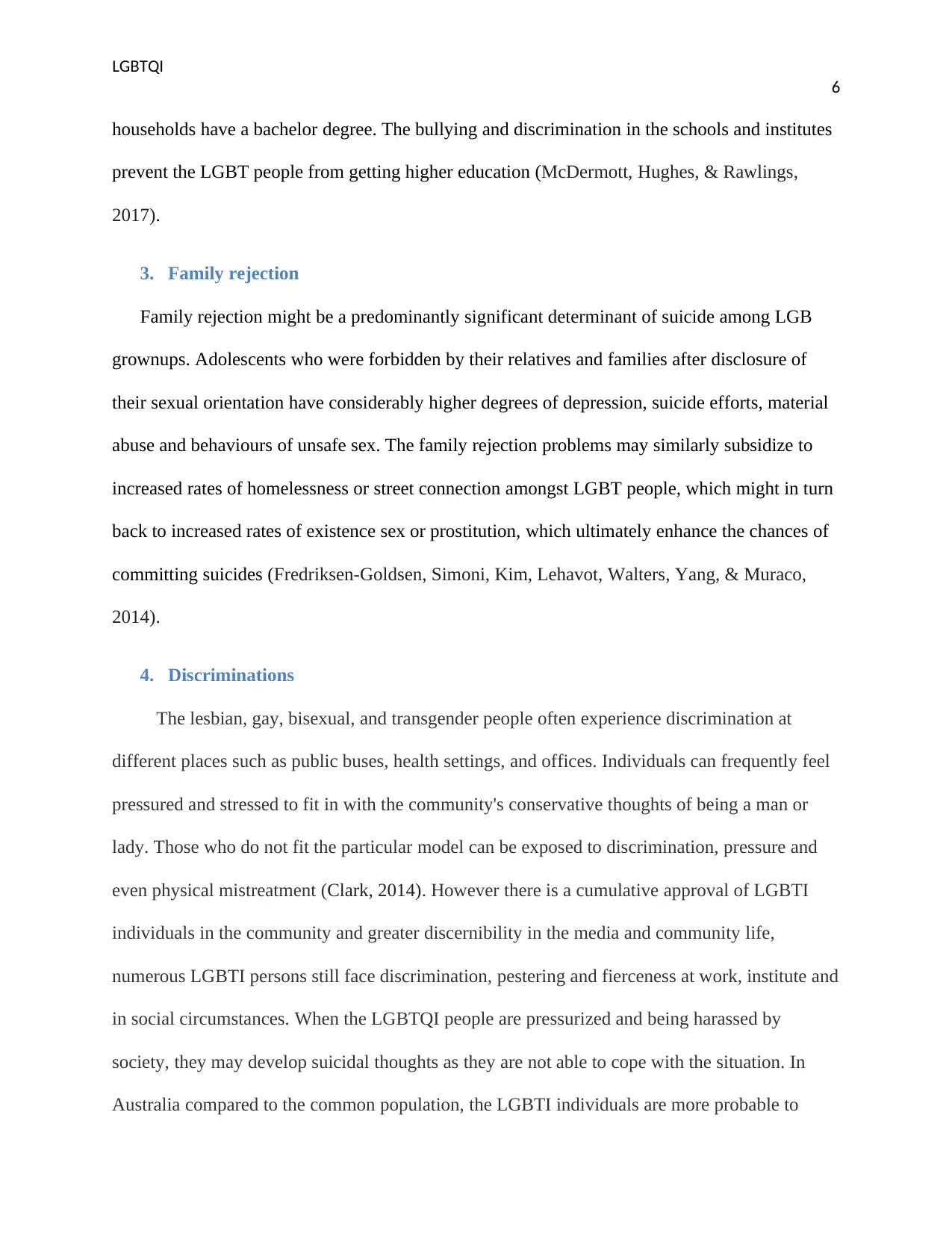
LGBTQI
6
households have a bachelor degree. The bullying and discrimination in the schools and institutes
prevent the LGBT people from getting higher education (McDermott, Hughes, & Rawlings,
2017).
3. Family rejection
Family rejection might be a predominantly significant determinant of suicide among LGB
grownups. Adolescents who were forbidden by their relatives and families after disclosure of
their sexual orientation have considerably higher degrees of depression, suicide efforts, material
abuse and behaviours of unsafe sex. The family rejection problems may similarly subsidize to
increased rates of homelessness or street connection amongst LGBT people, which might in turn
back to increased rates of existence sex or prostitution, which ultimately enhance the chances of
committing suicides (Fredriksen-Goldsen, Simoni, Kim, Lehavot, Walters, Yang, & Muraco,
2014).
4. Discriminations
The lesbian, gay, bisexual, and transgender people often experience discrimination at
different places such as public buses, health settings, and offices. Individuals can frequently feel
pressured and stressed to fit in with the community's conservative thoughts of being a man or
lady. Those who do not fit the particular model can be exposed to discrimination, pressure and
even physical mistreatment (Clark, 2014). However there is a cumulative approval of LGBTI
individuals in the community and greater discernibility in the media and community life,
numerous LGBTI persons still face discrimination, pestering and fierceness at work, institute and
in social circumstances. When the LGBTQI people are pressurized and being harassed by
society, they may develop suicidal thoughts as they are not able to cope with the situation. In
Australia compared to the common population, the LGBTI individuals are more probable to
6
households have a bachelor degree. The bullying and discrimination in the schools and institutes
prevent the LGBT people from getting higher education (McDermott, Hughes, & Rawlings,
2017).
3. Family rejection
Family rejection might be a predominantly significant determinant of suicide among LGB
grownups. Adolescents who were forbidden by their relatives and families after disclosure of
their sexual orientation have considerably higher degrees of depression, suicide efforts, material
abuse and behaviours of unsafe sex. The family rejection problems may similarly subsidize to
increased rates of homelessness or street connection amongst LGBT people, which might in turn
back to increased rates of existence sex or prostitution, which ultimately enhance the chances of
committing suicides (Fredriksen-Goldsen, Simoni, Kim, Lehavot, Walters, Yang, & Muraco,
2014).
4. Discriminations
The lesbian, gay, bisexual, and transgender people often experience discrimination at
different places such as public buses, health settings, and offices. Individuals can frequently feel
pressured and stressed to fit in with the community's conservative thoughts of being a man or
lady. Those who do not fit the particular model can be exposed to discrimination, pressure and
even physical mistreatment (Clark, 2014). However there is a cumulative approval of LGBTI
individuals in the community and greater discernibility in the media and community life,
numerous LGBTI persons still face discrimination, pestering and fierceness at work, institute and
in social circumstances. When the LGBTQI people are pressurized and being harassed by
society, they may develop suicidal thoughts as they are not able to cope with the situation. In
Australia compared to the common population, the LGBTI individuals are more probable to
Paraphrase This Document
Need a fresh take? Get an instant paraphrase of this document with our AI Paraphraser
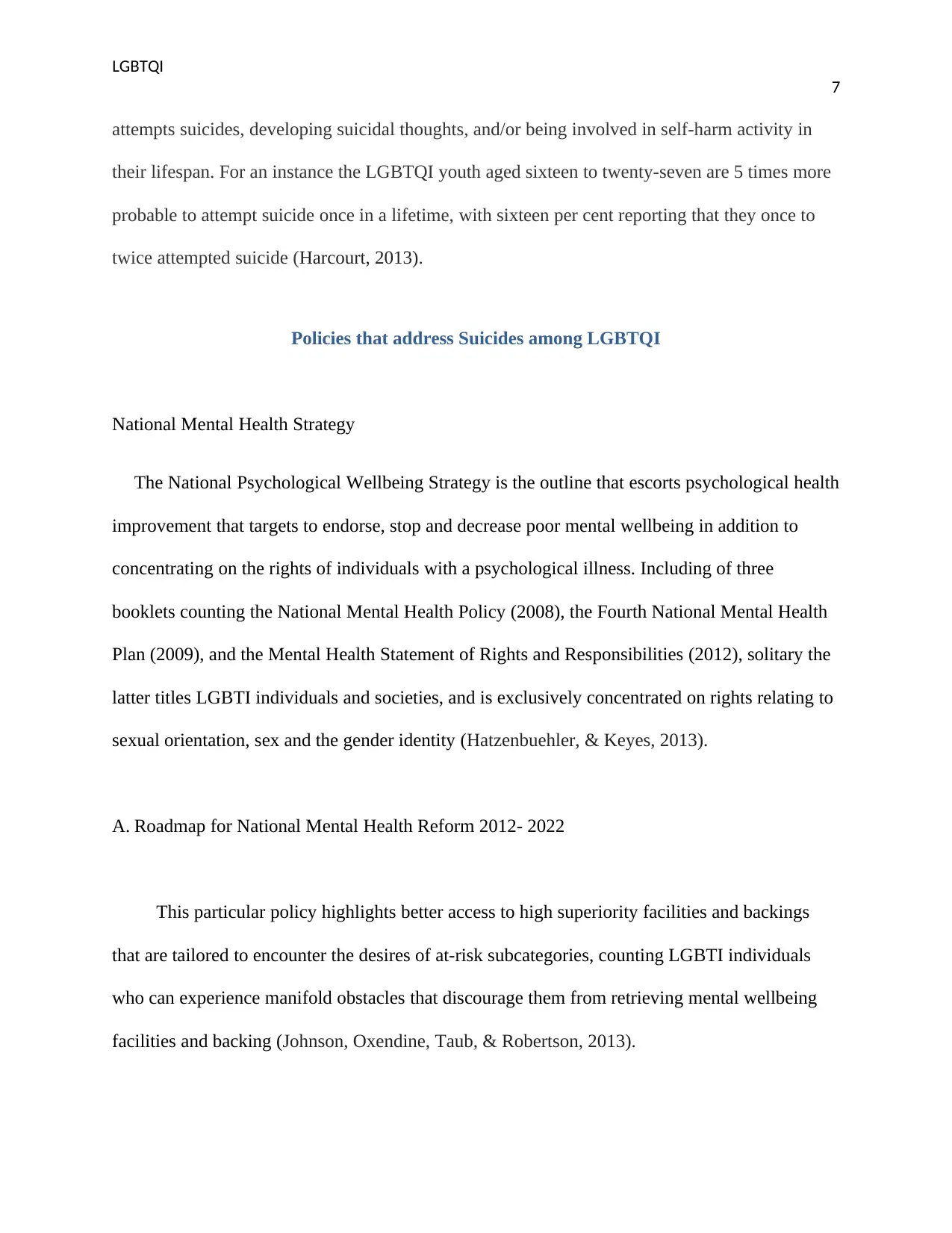
LGBTQI
7
attempts suicides, developing suicidal thoughts, and/or being involved in self-harm activity in
their lifespan. For an instance the LGBTQI youth aged sixteen to twenty-seven are 5 times more
probable to attempt suicide once in a lifetime, with sixteen per cent reporting that they once to
twice attempted suicide (Harcourt, 2013).
Policies that address Suicides among LGBTQI
National Mental Health Strategy
The National Psychological Wellbeing Strategy is the outline that escorts psychological health
improvement that targets to endorse, stop and decrease poor mental wellbeing in addition to
concentrating on the rights of individuals with a psychological illness. Including of three
booklets counting the National Mental Health Policy (2008), the Fourth National Mental Health
Plan (2009), and the Mental Health Statement of Rights and Responsibilities (2012), solitary the
latter titles LGBTI individuals and societies, and is exclusively concentrated on rights relating to
sexual orientation, sex and the gender identity (Hatzenbuehler, & Keyes, 2013).
A. Roadmap for National Mental Health Reform 2012- 2022
This particular policy highlights better access to high superiority facilities and backings
that are tailored to encounter the desires of at-risk subcategories, counting LGBTI individuals
who can experience manifold obstacles that discourage them from retrieving mental wellbeing
facilities and backing (Johnson, Oxendine, Taub, & Robertson, 2013).
7
attempts suicides, developing suicidal thoughts, and/or being involved in self-harm activity in
their lifespan. For an instance the LGBTQI youth aged sixteen to twenty-seven are 5 times more
probable to attempt suicide once in a lifetime, with sixteen per cent reporting that they once to
twice attempted suicide (Harcourt, 2013).
Policies that address Suicides among LGBTQI
National Mental Health Strategy
The National Psychological Wellbeing Strategy is the outline that escorts psychological health
improvement that targets to endorse, stop and decrease poor mental wellbeing in addition to
concentrating on the rights of individuals with a psychological illness. Including of three
booklets counting the National Mental Health Policy (2008), the Fourth National Mental Health
Plan (2009), and the Mental Health Statement of Rights and Responsibilities (2012), solitary the
latter titles LGBTI individuals and societies, and is exclusively concentrated on rights relating to
sexual orientation, sex and the gender identity (Hatzenbuehler, & Keyes, 2013).
A. Roadmap for National Mental Health Reform 2012- 2022
This particular policy highlights better access to high superiority facilities and backings
that are tailored to encounter the desires of at-risk subcategories, counting LGBTI individuals
who can experience manifold obstacles that discourage them from retrieving mental wellbeing
facilities and backing (Johnson, Oxendine, Taub, & Robertson, 2013).
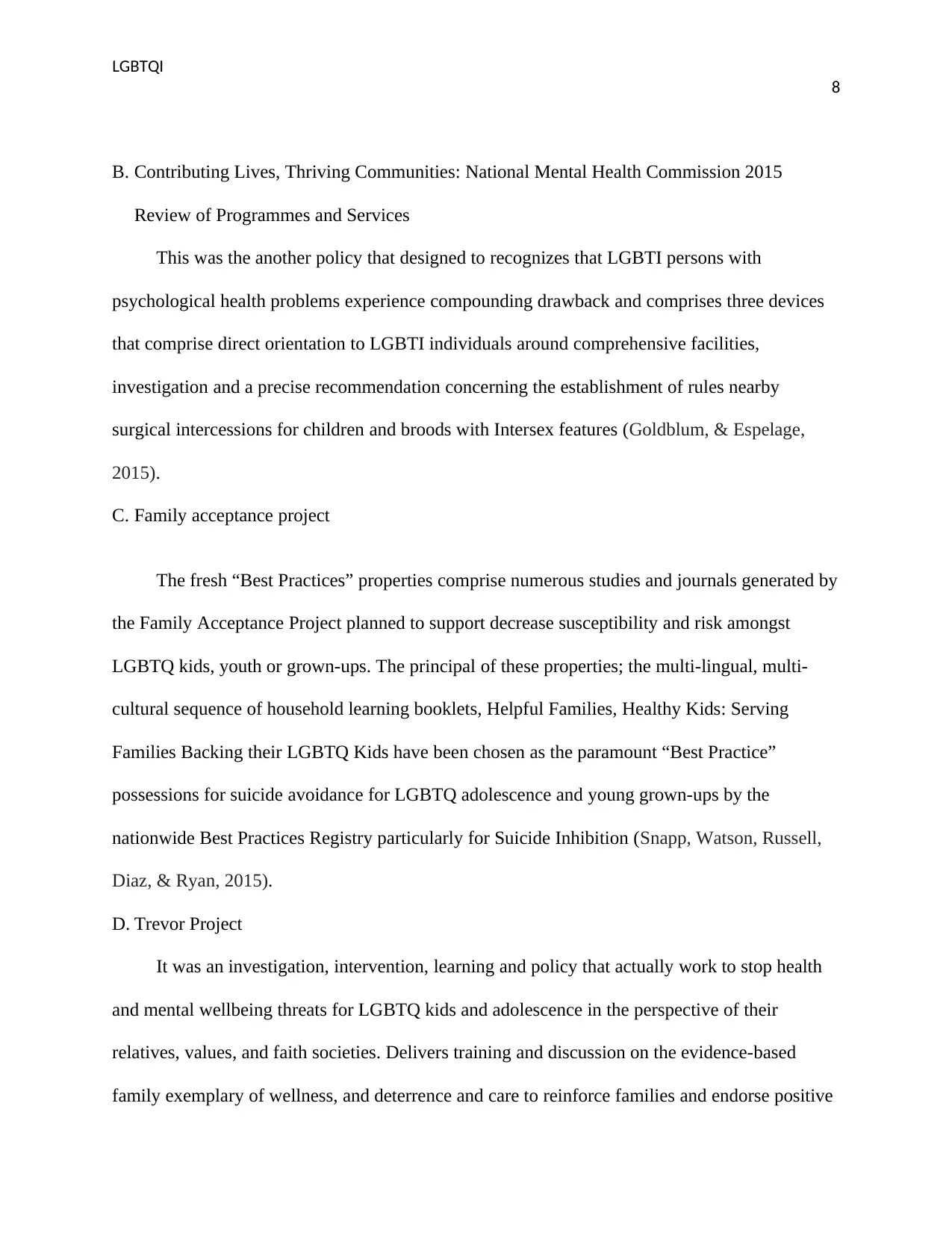
LGBTQI
8
B. Contributing Lives, Thriving Communities: National Mental Health Commission 2015
Review of Programmes and Services
This was the another policy that designed to recognizes that LGBTI persons with
psychological health problems experience compounding drawback and comprises three devices
that comprise direct orientation to LGBTI individuals around comprehensive facilities,
investigation and a precise recommendation concerning the establishment of rules nearby
surgical intercessions for children and broods with Intersex features (Goldblum, & Espelage,
2015).
C. Family acceptance project
The fresh “Best Practices” properties comprise numerous studies and journals generated by
the Family Acceptance Project planned to support decrease susceptibility and risk amongst
LGBTQ kids, youth or grown-ups. The principal of these properties; the multi-lingual, multi-
cultural sequence of household learning booklets, Helpful Families, Healthy Kids: Serving
Families Backing their LGBTQ Kids have been chosen as the paramount “Best Practice”
possessions for suicide avoidance for LGBTQ adolescence and young grown-ups by the
nationwide Best Practices Registry particularly for Suicide Inhibition (Snapp, Watson, Russell,
Diaz, & Ryan, 2015).
D. Trevor Project
It was an investigation, intervention, learning and policy that actually work to stop health
and mental wellbeing threats for LGBTQ kids and adolescence in the perspective of their
relatives, values, and faith societies. Delivers training and discussion on the evidence-based
family exemplary of wellness, and deterrence and care to reinforce families and endorse positive
8
B. Contributing Lives, Thriving Communities: National Mental Health Commission 2015
Review of Programmes and Services
This was the another policy that designed to recognizes that LGBTI persons with
psychological health problems experience compounding drawback and comprises three devices
that comprise direct orientation to LGBTI individuals around comprehensive facilities,
investigation and a precise recommendation concerning the establishment of rules nearby
surgical intercessions for children and broods with Intersex features (Goldblum, & Espelage,
2015).
C. Family acceptance project
The fresh “Best Practices” properties comprise numerous studies and journals generated by
the Family Acceptance Project planned to support decrease susceptibility and risk amongst
LGBTQ kids, youth or grown-ups. The principal of these properties; the multi-lingual, multi-
cultural sequence of household learning booklets, Helpful Families, Healthy Kids: Serving
Families Backing their LGBTQ Kids have been chosen as the paramount “Best Practice”
possessions for suicide avoidance for LGBTQ adolescence and young grown-ups by the
nationwide Best Practices Registry particularly for Suicide Inhibition (Snapp, Watson, Russell,
Diaz, & Ryan, 2015).
D. Trevor Project
It was an investigation, intervention, learning and policy that actually work to stop health
and mental wellbeing threats for LGBTQ kids and adolescence in the perspective of their
relatives, values, and faith societies. Delivers training and discussion on the evidence-based
family exemplary of wellness, and deterrence and care to reinforce families and endorse positive
⊘ This is a preview!⊘
Do you want full access?
Subscribe today to unlock all pages.

Trusted by 1+ million students worldwide
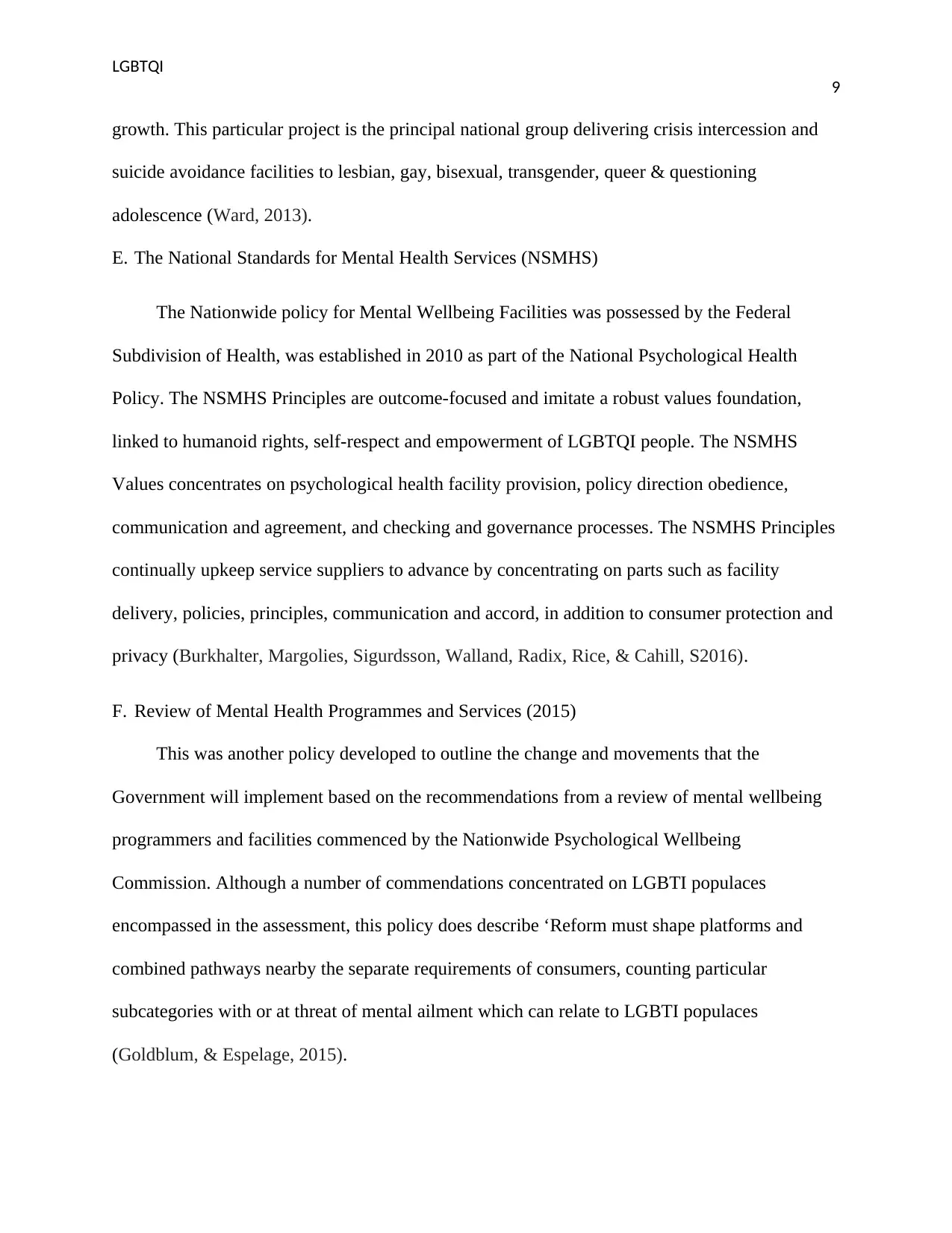
LGBTQI
9
growth. This particular project is the principal national group delivering crisis intercession and
suicide avoidance facilities to lesbian, gay, bisexual, transgender, queer & questioning
adolescence (Ward, 2013).
E. The National Standards for Mental Health Services (NSMHS)
The Nationwide policy for Mental Wellbeing Facilities was possessed by the Federal
Subdivision of Health, was established in 2010 as part of the National Psychological Health
Policy. The NSMHS Principles are outcome-focused and imitate a robust values foundation,
linked to humanoid rights, self-respect and empowerment of LGBTQI people. The NSMHS
Values concentrates on psychological health facility provision, policy direction obedience,
communication and agreement, and checking and governance processes. The NSMHS Principles
continually upkeep service suppliers to advance by concentrating on parts such as facility
delivery, policies, principles, communication and accord, in addition to consumer protection and
privacy (Burkhalter, Margolies, Sigurdsson, Walland, Radix, Rice, & Cahill, S2016).
F. Review of Mental Health Programmes and Services (2015)
This was another policy developed to outline the change and movements that the
Government will implement based on the recommendations from a review of mental wellbeing
programmers and facilities commenced by the Nationwide Psychological Wellbeing
Commission. Although a number of commendations concentrated on LGBTI populaces
encompassed in the assessment, this policy does describe ‘Reform must shape platforms and
combined pathways nearby the separate requirements of consumers, counting particular
subcategories with or at threat of mental ailment which can relate to LGBTI populaces
(Goldblum, & Espelage, 2015).
9
growth. This particular project is the principal national group delivering crisis intercession and
suicide avoidance facilities to lesbian, gay, bisexual, transgender, queer & questioning
adolescence (Ward, 2013).
E. The National Standards for Mental Health Services (NSMHS)
The Nationwide policy for Mental Wellbeing Facilities was possessed by the Federal
Subdivision of Health, was established in 2010 as part of the National Psychological Health
Policy. The NSMHS Principles are outcome-focused and imitate a robust values foundation,
linked to humanoid rights, self-respect and empowerment of LGBTQI people. The NSMHS
Values concentrates on psychological health facility provision, policy direction obedience,
communication and agreement, and checking and governance processes. The NSMHS Principles
continually upkeep service suppliers to advance by concentrating on parts such as facility
delivery, policies, principles, communication and accord, in addition to consumer protection and
privacy (Burkhalter, Margolies, Sigurdsson, Walland, Radix, Rice, & Cahill, S2016).
F. Review of Mental Health Programmes and Services (2015)
This was another policy developed to outline the change and movements that the
Government will implement based on the recommendations from a review of mental wellbeing
programmers and facilities commenced by the Nationwide Psychological Wellbeing
Commission. Although a number of commendations concentrated on LGBTI populaces
encompassed in the assessment, this policy does describe ‘Reform must shape platforms and
combined pathways nearby the separate requirements of consumers, counting particular
subcategories with or at threat of mental ailment which can relate to LGBTI populaces
(Goldblum, & Espelage, 2015).
Paraphrase This Document
Need a fresh take? Get an instant paraphrase of this document with our AI Paraphraser
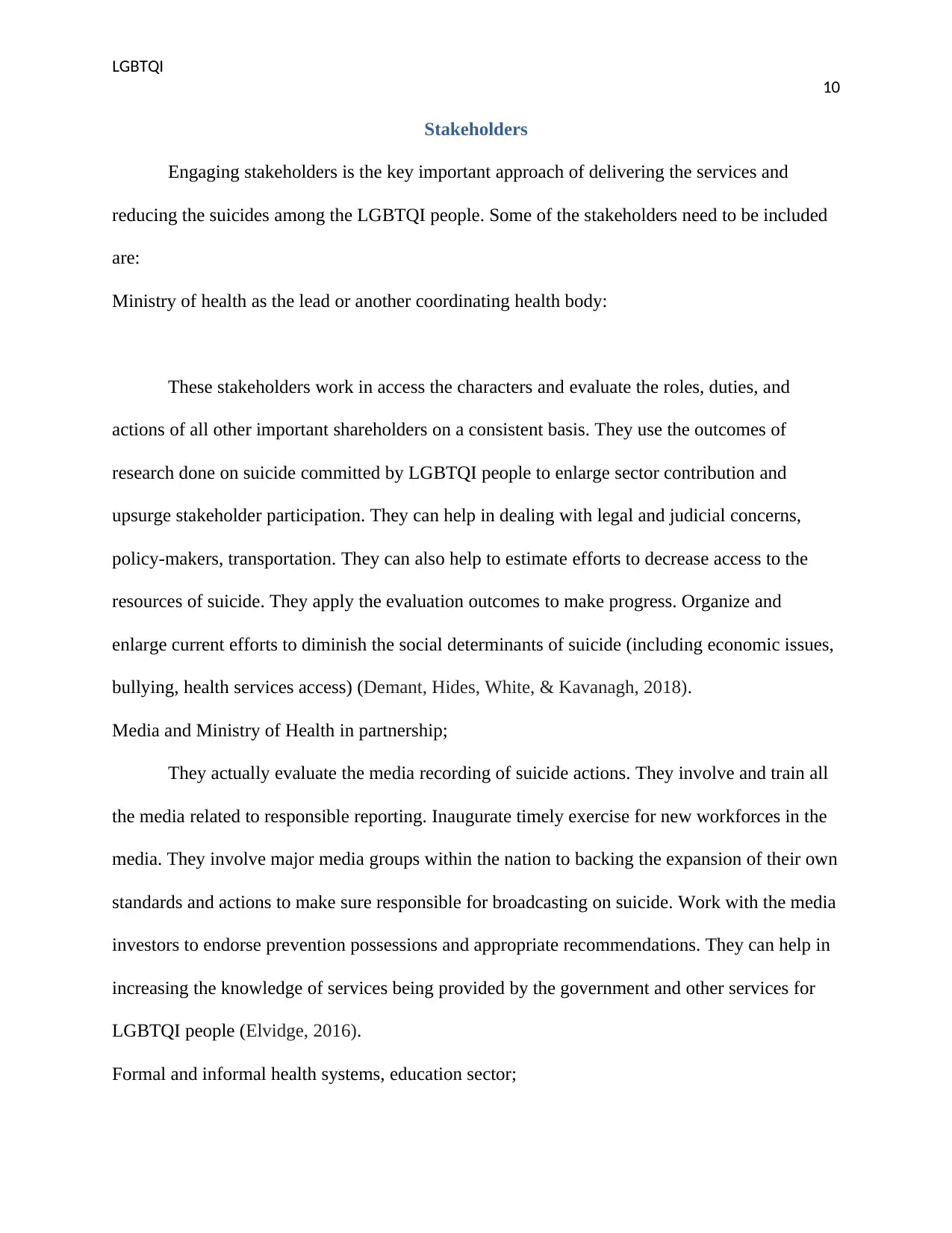
LGBTQI
10
Stakeholders
Engaging stakeholders is the key important approach of delivering the services and
reducing the suicides among the LGBTQI people. Some of the stakeholders need to be included
are:
Ministry of health as the lead or another coordinating health body:
These stakeholders work in access the characters and evaluate the roles, duties, and
actions of all other important shareholders on a consistent basis. They use the outcomes of
research done on suicide committed by LGBTQI people to enlarge sector contribution and
upsurge stakeholder participation. They can help in dealing with legal and judicial concerns,
policy-makers, transportation. They can also help to estimate efforts to decrease access to the
resources of suicide. They apply the evaluation outcomes to make progress. Organize and
enlarge current efforts to diminish the social determinants of suicide (including economic issues,
bullying, health services access) (Demant, Hides, White, & Kavanagh, 2018).
Media and Ministry of Health in partnership;
They actually evaluate the media recording of suicide actions. They involve and train all
the media related to responsible reporting. Inaugurate timely exercise for new workforces in the
media. They involve major media groups within the nation to backing the expansion of their own
standards and actions to make sure responsible for broadcasting on suicide. Work with the media
investors to endorse prevention possessions and appropriate recommendations. They can help in
increasing the knowledge of services being provided by the government and other services for
LGBTQI people (Elvidge, 2016).
Formal and informal health systems, education sector;
10
Stakeholders
Engaging stakeholders is the key important approach of delivering the services and
reducing the suicides among the LGBTQI people. Some of the stakeholders need to be included
are:
Ministry of health as the lead or another coordinating health body:
These stakeholders work in access the characters and evaluate the roles, duties, and
actions of all other important shareholders on a consistent basis. They use the outcomes of
research done on suicide committed by LGBTQI people to enlarge sector contribution and
upsurge stakeholder participation. They can help in dealing with legal and judicial concerns,
policy-makers, transportation. They can also help to estimate efforts to decrease access to the
resources of suicide. They apply the evaluation outcomes to make progress. Organize and
enlarge current efforts to diminish the social determinants of suicide (including economic issues,
bullying, health services access) (Demant, Hides, White, & Kavanagh, 2018).
Media and Ministry of Health in partnership;
They actually evaluate the media recording of suicide actions. They involve and train all
the media related to responsible reporting. Inaugurate timely exercise for new workforces in the
media. They involve major media groups within the nation to backing the expansion of their own
standards and actions to make sure responsible for broadcasting on suicide. Work with the media
investors to endorse prevention possessions and appropriate recommendations. They can help in
increasing the knowledge of services being provided by the government and other services for
LGBTQI people (Elvidge, 2016).
Formal and informal health systems, education sector;
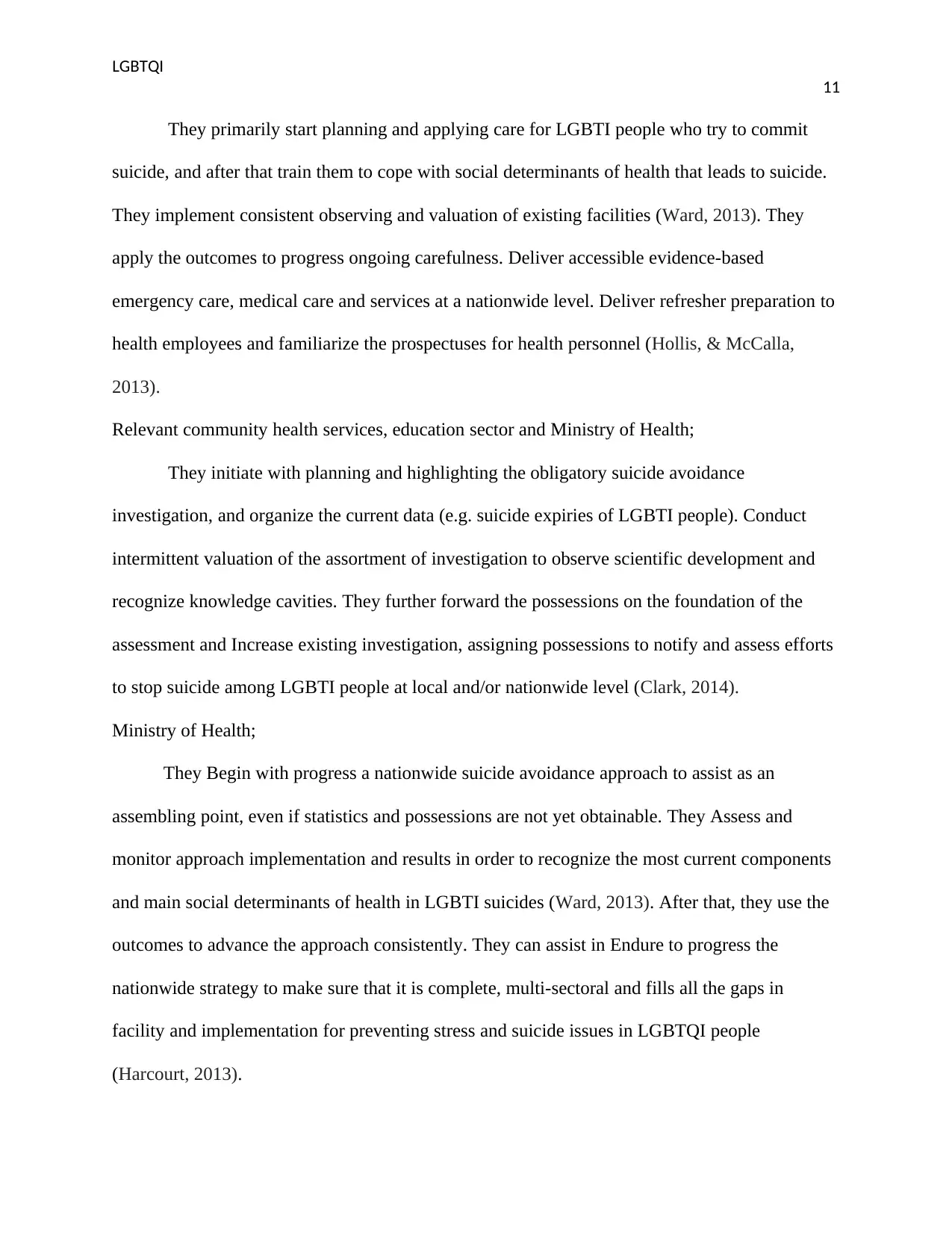
LGBTQI
11
They primarily start planning and applying care for LGBTI people who try to commit
suicide, and after that train them to cope with social determinants of health that leads to suicide.
They implement consistent observing and valuation of existing facilities (Ward, 2013). They
apply the outcomes to progress ongoing carefulness. Deliver accessible evidence-based
emergency care, medical care and services at a nationwide level. Deliver refresher preparation to
health employees and familiarize the prospectuses for health personnel (Hollis, & McCalla,
2013).
Relevant community health services, education sector and Ministry of Health;
They initiate with planning and highlighting the obligatory suicide avoidance
investigation, and organize the current data (e.g. suicide expiries of LGBTI people). Conduct
intermittent valuation of the assortment of investigation to observe scientific development and
recognize knowledge cavities. They further forward the possessions on the foundation of the
assessment and Increase existing investigation, assigning possessions to notify and assess efforts
to stop suicide among LGBTI people at local and/or nationwide level (Clark, 2014).
Ministry of Health;
They Begin with progress a nationwide suicide avoidance approach to assist as an
assembling point, even if statistics and possessions are not yet obtainable. They Assess and
monitor approach implementation and results in order to recognize the most current components
and main social determinants of health in LGBTI suicides (Ward, 2013). After that, they use the
outcomes to advance the approach consistently. They can assist in Endure to progress the
nationwide strategy to make sure that it is complete, multi-sectoral and fills all the gaps in
facility and implementation for preventing stress and suicide issues in LGBTQI people
(Harcourt, 2013).
11
They primarily start planning and applying care for LGBTI people who try to commit
suicide, and after that train them to cope with social determinants of health that leads to suicide.
They implement consistent observing and valuation of existing facilities (Ward, 2013). They
apply the outcomes to progress ongoing carefulness. Deliver accessible evidence-based
emergency care, medical care and services at a nationwide level. Deliver refresher preparation to
health employees and familiarize the prospectuses for health personnel (Hollis, & McCalla,
2013).
Relevant community health services, education sector and Ministry of Health;
They initiate with planning and highlighting the obligatory suicide avoidance
investigation, and organize the current data (e.g. suicide expiries of LGBTI people). Conduct
intermittent valuation of the assortment of investigation to observe scientific development and
recognize knowledge cavities. They further forward the possessions on the foundation of the
assessment and Increase existing investigation, assigning possessions to notify and assess efforts
to stop suicide among LGBTI people at local and/or nationwide level (Clark, 2014).
Ministry of Health;
They Begin with progress a nationwide suicide avoidance approach to assist as an
assembling point, even if statistics and possessions are not yet obtainable. They Assess and
monitor approach implementation and results in order to recognize the most current components
and main social determinants of health in LGBTI suicides (Ward, 2013). After that, they use the
outcomes to advance the approach consistently. They can assist in Endure to progress the
nationwide strategy to make sure that it is complete, multi-sectoral and fills all the gaps in
facility and implementation for preventing stress and suicide issues in LGBTQI people
(Harcourt, 2013).
⊘ This is a preview!⊘
Do you want full access?
Subscribe today to unlock all pages.

Trusted by 1+ million students worldwide
1 out of 17
Related Documents
Your All-in-One AI-Powered Toolkit for Academic Success.
+13062052269
info@desklib.com
Available 24*7 on WhatsApp / Email
![[object Object]](/_next/static/media/star-bottom.7253800d.svg)
Unlock your academic potential
Copyright © 2020–2025 A2Z Services. All Rights Reserved. Developed and managed by ZUCOL.





